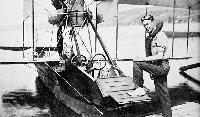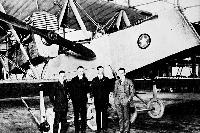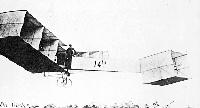Книги
Putnam
G.Loening
Takeoff into Greatness
40
G.Loening - Takeoff into Greatness /Putnam/
The modified DH-4 made into a highly successful mail plane. The pilot sat back of the gas tank and the mail compartment.
CYGNET II (1908). Designed by Dr. Graham Bell, of the Aeronautical Society of America. Bell (Canadian), Glen Curtis (U.S.), Herring (U.S.), and Burgess (Canadian). Built at Baddeck, Nova Scotia in February 1909. J. A. D. McCurdy made a short hop with this plane. There was no lateral control.
The June Bug on a flight for the Scientific American Trophy, July 4, 1908. Standing left to right: A. M. Herring, "Casey" Baldwin, Glenn Curtiss, Dr. C. M. Manly, Stanley Beach, J. A. D. McCurdy.
The Signal Corps tractor, the first development project of the Experimental and Repair Division of the Army School (which later grew into the Engineering Division). This plane, a modified Burgess, incorporated trailing edge ailerons instead of warping, and had a simple two-wheel landing gear, later to become widely used. Many records were made with this plane.
While the Wright Company was worrying about patents, Curtiss was busy pioneering the hydroairplane. This photo shows the first successful seaplane, with Curtiss testing it in 1911, two years ahead of the Wright flying boat effort. Note the ailerons between the wings designed to bypass the Wright patent.
Curtiss Aeroplane Company photo of F flying boat used for training. Ray Morris tests the pilot seat. Standing, Beckwith Havens, famous exhibition flyer.
This plane and the H16 boat were the chief products of the air industry for the war. This is the famous Jennie, the Curtiss JN4-D.
Scene at Potomac Park, Washington, D.C., May 15, 1918, when the Air Mail Service was started by the Army with a Curtiss JN-4H airplane.
Dayton-Wright production under way with difficulties on the 4,000 DH-4 plane order that never materialized.
Thomas Walker’s proposed tandem monoplane was designed to have inherent stability, countering fore-and-aft pitching, by the disposition of the plane surfaces in the rear. It never flew, but it inspired a number of successors, including S. P. Langley’s Aerodrome A, seen on its launching catapult-rig in the Potomac river before a (disastrous) take-off in 1903 ...
Glenn L. Martin in his very strongly constructed pusher type of exhibition machine, built by himself. Powered by a Curtiss engine, it was at the time considered the best constructed aircraft in use.
The Army Signal Corps Aviation Section Flying School at San Diego, California, scene of the greatest U.S. aviation activity starting in 1913. Here was introduced the Martin TT training plane of tractor type, which was to play such an important role in the safety of our air operations.
The Martin bomber MB1. Standing left to right are its creators: Larry Bell; Eric Springer; Glenn Martin; Donald Douglas.
The Kitty Hawk, the first successful flying machine, standing in front of Kill Devil Hill, North Carolina, December 1903.
Orville Wright and Lt. Selfridge, ready for takeoff. The plane is mounted on the wooden catapult rail.
Flight 46, made on October 1905, was the last flight of the season to be photographed. With Orville piloting, the Flyer III, the world's first practical povered aeroplane, remained aloft at a height of 40-60ft (12-18m) for 33min 17sec and covered 20 3/4 miles (33,456m).
The Wrights' 1904 biplane making the world's first circular flight at Dayton, Ohio, September 1904. (???)
The Wrights' 1904 biplane making the world's first circular flight at Dayton, Ohio, September 1904. (???)
Arch Hoxsey, Wright flyer at the 1912 St. Louis Air Meet, caps the prewar exhibition era by giving a ride to the President of the United States, Theodore Roosevelt.
The Army's first plane wreck at Fort Myer, September 17, 1908. The man with the straw hat is Lorin Wright.








































